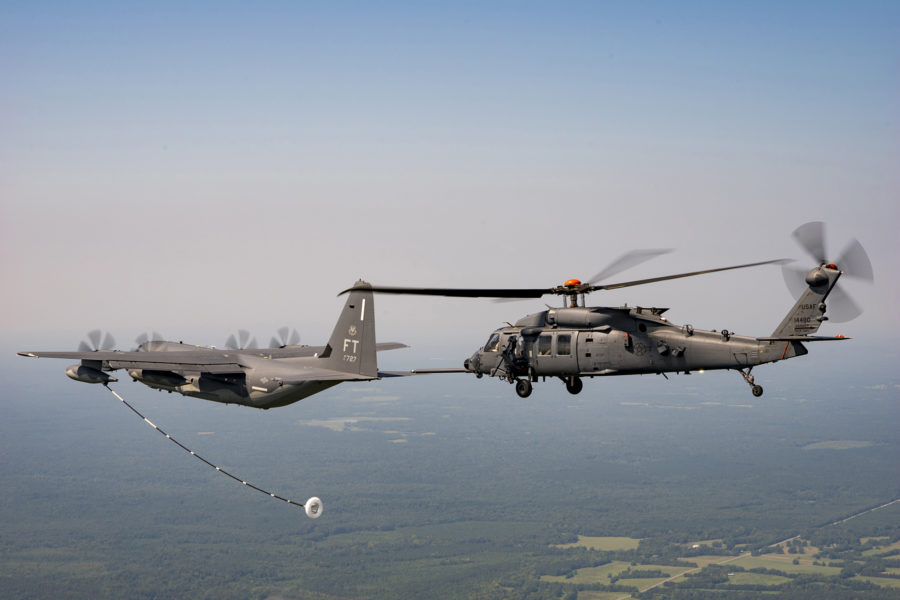As the Air Force prepares to declare initial operating capability for the HH-60W Jolly Green II, the service’s new combat search and rescue helicopter, the manufacturer is pushing back against the idea that its helicopter isn’t suited to combat in the Pacific—and against planned cuts to USAF’s purchase.
Sikorsky Aircraft, a Lockheed Martin subsidiary, has delivered 23 of 65 HH-60Ws on order. The Air Force’s fiscal 2023 budget request would fund 10 more, but that would close out the service’s planned purchases, well short of the 113 Jolly Green IIs originally planned.
David Morgan, a former HH-60G Pave Hawk pilot who is now the Air Force business development manager at Sikorsky, said the Jolly Green II, while still carrying the HH-60 designator, is not just a spiffed up Pave Hawk.
“A lot of people think it’s just more of the same, but it is a completely new generation of aircraft,” Morgan said. Among the changes: A bigger internal main fuel tank that holds almost 300 more gallons, eliminating auxiliary tanks from from inside the cabin; seats for pararescue jumpers that fold up into the ceiling; and “all kinds of sensors and communications” that enable survivors’ signals to go “right to the aircraft, digitally.”
Those features will keep it relevant in the Pacific, he argued. And without an alternative in hand, cutting the purchase now may not make sense.
Congress could still increase the Jolly Green II purchase. Both the Senate Armed Services and Appropriations committees support taking the total to 85 aircraft in the 2023 National Defense Authorization bill. The Senate Appropriations Committee markup questioned “the strategic underpinning of these and other acquisition decisions,” and both the House and Senate Armed Services committees have called for a review.
Military planners say the transition from a focus on counter-insurgency to peer power competition, particularly in the Pacific where distances are far greater, changes requirements. They question the value of a helicopter to conduct long-range rescues in case of combat with China. Air Combat Command boss Gen. Mark D. Kelly has said he does not see how the Jolly Green II would be able to recover survivors behind enemy lines in Asia.
Reducing the fleet to 75 helicopters “is really going to put a strain on this fleet for the Air Force,” Morgan contended. With a fleet of 112, the Pave Hawk “has always been considered a low density, high demand aircraft. They’re always over deployed, with very little time to reset and train.”
He thinks the Air Force’s worries about survivability in the Pacific could be soothed as the Jolly Green II enters service.
“I think the concern is, with the Air Force, about survivability and some of the speed and the range in the near-peer fight,” Morgan said. “But, you know, this aircraft does have a refueling probe, air refueling, so it should have unlimited range. They can preposition the aircraft in support of any anticipated operations.” He suspects it won’t fly “single-aircraft, alone, unafraid, into some of these fights” but instead “go with packages. … They’re going to provide air superiority. They’re going to provide … support for the aircraft. So it’s not going to be the only aircraft on the search and rescue.”
And for now, “it’s still being tested, and we don’t understand the full capabilities of this aircraft. So I think making assumptions before all that’s figured out could be premature.”
Edward Stanhouse, deputy program executive officer for intelligence, surveillance, reconnaissance, and special operations forces, has said that in terms of an alternative, a team “is looking at a variety of technologies, in that exploration mode right now, from … [amphibious to] potential applications of some of those unmanned applications. A lot of work, a lot of conceptual work, I think, has to be done in that area to do the proof of concepts.”
So far Sikorsky has trained about 200 pilots and crew members on the Jolly Green II. The HH-60W program director for Sikorsky, Steven Hill, said he’d recently met and flown with some of the crews, “and what you hear is they just love the aircraft,” he said. “It just gives them a lot more capability than they’ve ever had before. They’re just excited about getting it into their hands and getting out and getting deployed eventually.”
The U.S. may not have the only military with the Jolly Green II in the long run.
“We’ve had international interest for the last several years,” Morgan confirmed. “We’ve had several countries following the development and asking for pricing and availability. We’ve provided that as best we can, based on the development stage. We’ve got a couple countries right now that are very interested, so we’re working through options and potential with the Air Force for export.”
